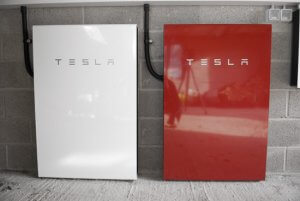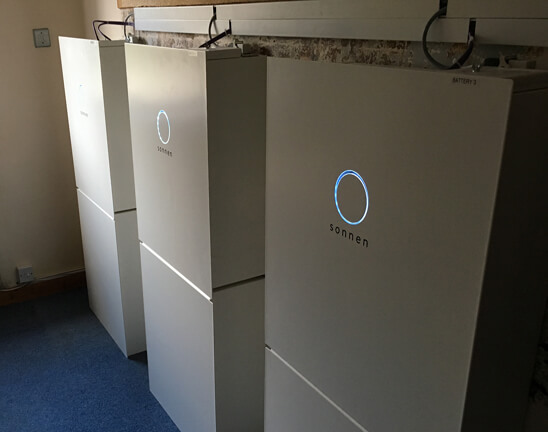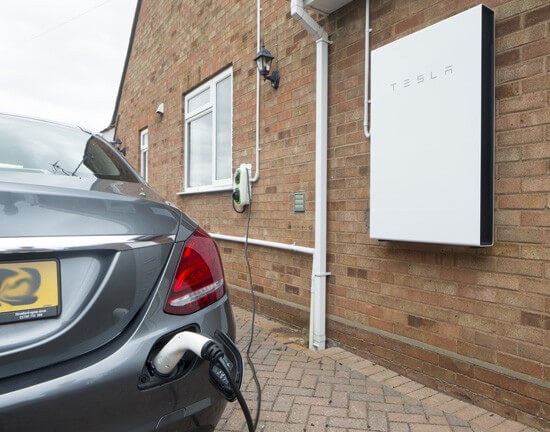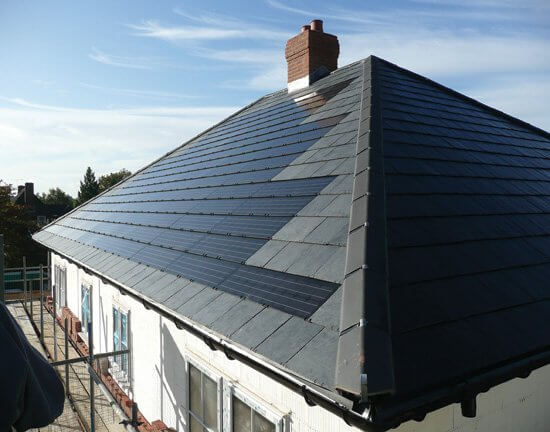If you're wondering whether the Tesla Powerwall 2 is the right system for you, this page answers some commonly asked questions about common uses of Powerwalls in the UK, and explains how they work.

Tesla Powerwall

Whether you're a homeowner with an existing solar PV system (or plan to have one installed) and want to make the most of the energy your panels are producing, or you're considering a public sector or business installation for energy storage batteries, read on to find out more about the Tesla Powerwall 2 and its many possible applications.
You can also download our free Tesla Powerwall 2 guide here for a more in-depth look at this battery storage solution.
The Tesla Powerwall 2 for homes
If you're a solar homeowner, a battery storage system like the Tesla Powerwall 2 can help you make the most of the electricity being generated by your solar array. The Tesla Powerwall minimises the amount of electricity your home needs to draw from the grid, making your home more self-sufficient.
By capturing and storing excess electricity generated by your solar panels during the day, that energy can then be used by your home during the evenings or on days with poorer weather, which can reduce your electricity bills significantly.
The Tesla Powerwall comes with the ability to ride through powercuts, giving your home added security. It's like having insurance for your home energy system.
It's also possible to fill the Powerwall with cheap night-time electricity, which is especially useful in winter when there is less solar energy to be captured by the battery. With a solar PV array and a Powerwall, you might never pay full price for your electricity again.
With its large 13.4kWh energy storage capacity, the Tesla Powerwall 2 is an ideal companion for larger households, or for those wanting to run their car on sunshine. For smaller households or those with smaller solar arrays, other battery storage options may be more suitable.
The Tesla Powerwall is a beautifully designed, sleek, minimalist product which looks great inside (or outside!) any home. The battery system comes with a clear and informative mobile phone app to show you when your battery is charging and discharging, and showing how little grid electricity you are consuming.

Frequently asked questions about the Tesla Powerwall 2
What is a Powerwall?
The Tesla Powerwall 2 is a battery storage system, primarily designed to be used with a solar PV system to store excess electricity which can then be used when the sun isn't shining i.e. overnight or on days with poor weather. A Tesla Powerwall with back up gateway can also be used to provide electricity to the building in the event of a power cut.
The Tesla Powerwall 2 can be in virtually any building with a solar PV system, whether that's a home, a commercial or a public building. It works best when there is plenty of excess day-time solar electricity that would otherwise be exported back to the grid.
The previous generation of this system was called the Tesla Powerwall, which had a smaller battery capacity and fewer features. Details of a forthcoming Powerwall 3 are yet to be announced by Tesla.
How does the Powerwall work?
The Tesla Powerwall 2 is a rechargeable lithium-ion battery system designed to use the electricity generated by sunshine with your solar PV system, which is over and above what the building needs during daylight hours, to charge the battery. This stored electricity can then be used to power the building once the sun has gone down or during poor weather or power cuts (if the back up gateway is fitted).
Tesla Powerwall 2 systems are designed to work with any solar PV setup because they use AC power (rather than DC) so can easily be retrofitted to an existing solar PV system.
The Powerwall 2 is cnnected directly to the building's standard electrics, so when the energy stored by the battery has been used up and if no solar energy is available directly from your PV system, you automatically draw what is needed from the national grid instead.
The Tesla Powerwall 2 can be installed indoors or outdoors and can help to reduce energy bills significantly, especially over the summer months, as well as being a way to ensure your home has power in the event of a temporary power cut.
Our Technical Director, Dr Chris Jardine, explains how the Powerwall works in this Fully Charged video from 2017 (please note that the back-up gateway was not available at the time of filming)
How long does a Tesla Powerwall battery last?
There are two aspects to how long a Tesla Powerwall 2 battery system will last. We cover them both here:
How long can a Powerwall power my home or business for?
The amount of time that a Tesla Powerwall 2 will be able to power a building for will depend on a the electricity demand within the building (such as lights, appliances, and potentially an electric car). The average household uses around 10 kWh (kilowatt hours) per 24-hour period (and much less if using solar power during a sunny day). This means that your Tesla Powerwall 2 could potentially power your home for at least a day with its 13.4 kWh of battery storage, from a full charge.
We are also seeing many households store solar energy during the day when they are out, run their home through the evening, and then empty the remaining solar electricity into their electric car. The battery is then completely empty, to repeat the cycle again the next day.
The Powerwall can supply 5kW of power at any one instant, so can cover the usage of all but the most thirsty appliances running at the same time. A kettle, at 3kW, would be fine, but electric power showers (10kW), and fast EV chargers (7kW) would only be partially covered.
For buildings with greater power needs, such as some businesses, it's possible to incorporate multiple Tesla Powerwall 2 units into your system, increasing the amount of battery storage capacity available, and the instantaneous power that can be delivered. Depending on the number of Powerwall units included in your setup and the electricity demands of the home or business, this could mean that you have enough electricity stored to power the building for significantly longer than with a single Powerwall unit.

What is the lifecycle of the battery in a Tesla Powerwall 2?
Tesla Powerwall 2 systems come with a 10-year manufacturer's warranty for unlimited cycles and 80% of the original energy capacity, when the system is charged using solar energy. This means that if your Powerwall falls below 80% of the original capacity during those 10-years, you qualify for a replacement.
It is expected that most Powerwall batteries will continue to function effectively for many years after the warranty runs out, although energy capacity will reduce a little over time.
How much is a Tesla Powerwall 2 in the UK?
The current price for a fully installed Tesla Powerwall 2 system will be between £8,600 and £10,500 depending on the complexity of the installation needed, and the VAT rate you are eligible for. You can contact us for an accurate quote of installation costs for a Powerwall 2 at your home or business.
The Tesla Powerwall is the cheapest home battery per kWh of storage capacity. It is possible to get cheaper batteries than the Tesla Powerwall, but they will store less electricity, and be able to supply less instantaneous power.

How many kWh is a Tesla Powerwall 2?
A Tesla Powerwall 2 has a 13.4 kWh capacity, with 13.2 kWh of that being usable for energy storage. It has a power output of up to 5 kW, which can cover more demand for electricity at peak times e.g. if several appliances are running at once. For example, a kettle uses around 3 kW of power and a 1000-Watt microwave uses 1 kW – so the battery can supply enough power for both to run at the same time without needing to draw anything from the grid (assuming the Powerwall 2 has sufficient charge to do so).
How many solar panels are needed to charge a Tesla Powerwall 2?
When calculating the solar energy needed to charge a Tesla Powerwall 2, it's the rating of the panels in your solar PV system as much as the number of panels that determine how much energy they can generate to charge the battery storage system. The ratings of your panels, when added together, give a number of kW that can feed into the Powerwall battery, but some of this electricity will also be used by your building at the same time.
For example, a fairly large residential 4 kW solar array (around 16 panels, depending on their rating) could produce around 20 kWh of electricity on an average sunny summer day, which would be enough to fully charge a Tesla Powerwall 2 and run your home. A Powerwall can run an average home throughout spring, summer and autumn, and for even longer if your demand is low.
At times of the year with less hours of light and sunshine, the same solar array might only produce about a quarter of the kWh that it does in the summer, which usually means that you will need to use more electricity from the grid, along with your Tesla Powerwall 2.
You can also charge a Tesla Powerwall 2 from the grid as well as via solar PV, which can work well for those with an economy electricity tariff that gives them cheaper electricity overnight, meaning that they can use the battery system more during the day and not need to draw as much from the grid as they otherwise would, at the more expensive rate.
Does the Tesla Powerwall 2 still work if there's a power cut?
Yes, the Tesla Powerall now comes with a back-up gateway. The gateway sits on the incoming electricity supply to the house, and if it detects a problem on the grid, a relay trips and your house is physically disconnected from the grid. Once you are physically disconnected like this, your battery can discharge to run the loads in your home, without causing a safety risk to workmen fixing the power cut on the grid. It provides you with extra security, knowing you'll always have power in your home.
In this 2019 episode of Fully Charged, Dr Chris Jardine explains how the back-up gateway works, showcasing the installation we have done with Robert Llewellyn.
The Tesla Powerwall 2 for businesses
We are seeing an increased demand from businesses looking to incorporate solar arrays and Tesla Powerwalls to reduce their electricity bills. Implementing battery storage solutions for businesses can be complicated, and we'd only recommend it in certain circumstances. We don't want to sell you a battery storage system that won't be fully utilised. Solar PV combined with Tesla Powerwalls are great for businesses where:
- Evening consumption is greater than the daytime, such as hotels, or if you are the owner/operator of housing blocks. This means there's lots of unused power in the day which can then be used at night.
- Where the solar array generates a large excess of power (usually a combination of large array and small daytime loads). This ensures there's excess electricity that can be captured all year round
- Or where there's a big difference between the day and night price of electricity. This allows cheap night-time electricity to be stored and used to offset expensive imported electricity.
We do not recommend installing solar PV combined with Tesla Powerwalls for businesses where:
- Daytime load is high, and/or solar generation is low. You'd capture some solar at midday on the sunniest days of the year, but for the rest of the year there wouldn't be enough excess solar to charge the batteries.
Our engineers can model this for you to see if this is a viable option for your property. Contact our commercial design team to find out more.

The Tesla Powerwall 2 for public sector installations
More and more public buildings and public sector organisations are turning to renewables like solar PV to provide for some or all of their energy needs, especially now many of them have declared a Climate Emergency. Larger buildings can lend themselves very well to solar, because of the expansive roof space available for big solar arrays. In these types of settings, it can also make sense to incorporate battery storage, subject to the same caveats as described above for commercial properties.
This can help to cover days when the weather or daylight hours are not quite sufficient to provide for the building's needs during the day or can provide additional power for things such as electric vehicle charging for fleet or staff vehicles.
See this case study for a great example of how a council is using Tesla Powerwall 2 units with their solar PV system and EV chargers. The multi-storey car park has low daytime usage and a large excess of solar PV making it ideal for a battery storage system.
Councils may also be interested to use the Tesla Powerwall for their social housing tenants, even without solar PV. Charging the Tesla Powerwall with cheap night time electricity, and then using it during the day, means fuel poor households can access electricity at 1/3 the price that they are currently paying.
For more information on the Tesla Powerwall 2 or any of the other energy battery storage solutions that we offer, for homes, public sector installations and businesses, get in touch today.
Download our FREE GUIDE
Find out if Tesla’s new Powerwall 2 is the right battery for you:












